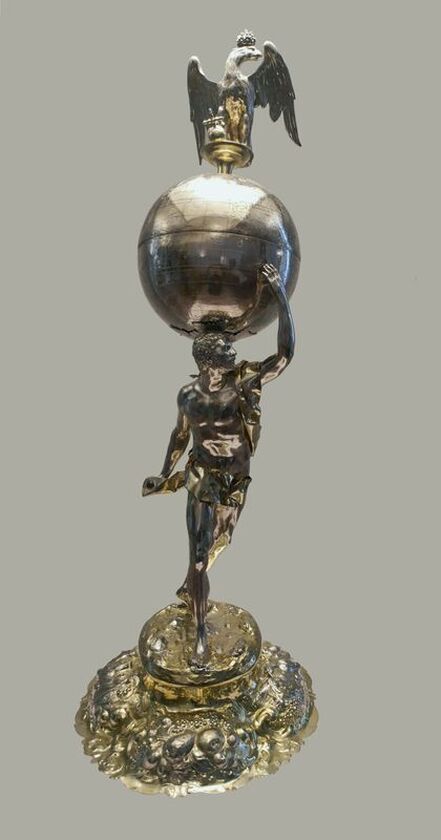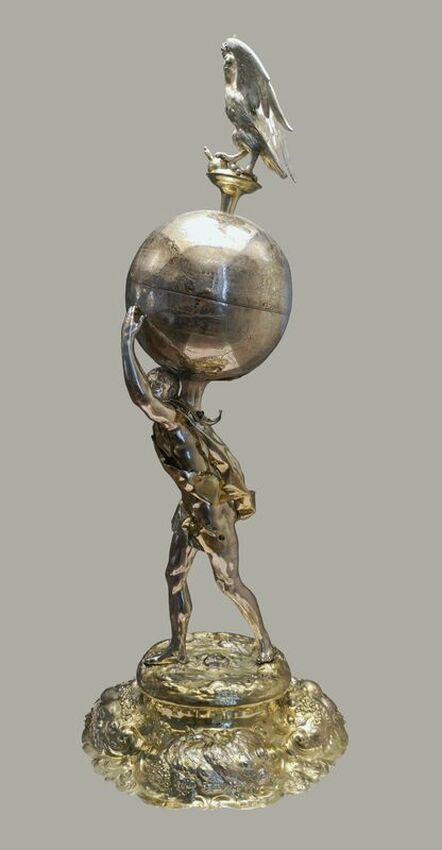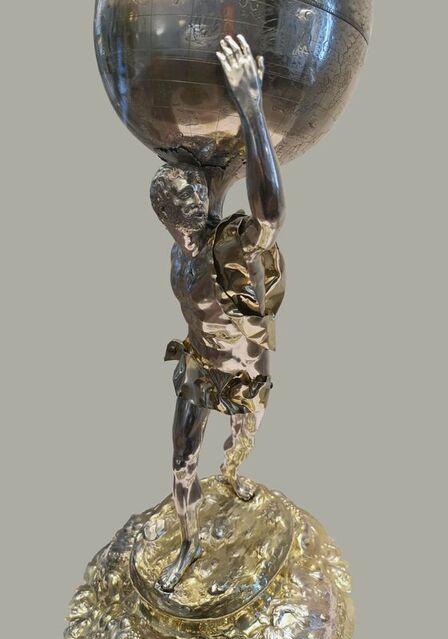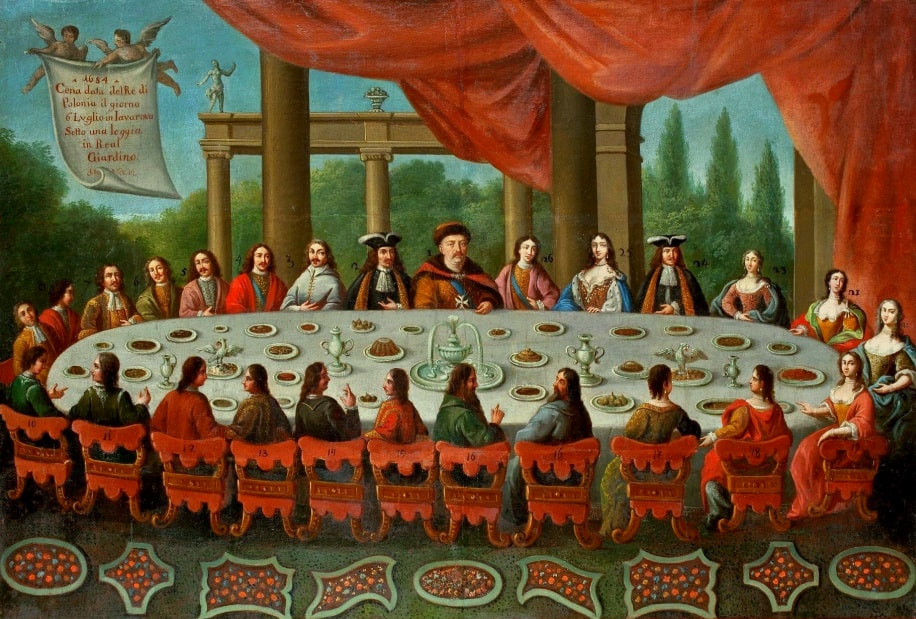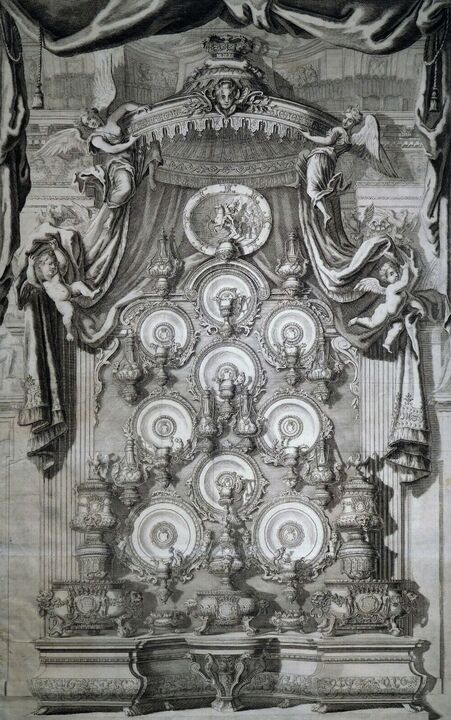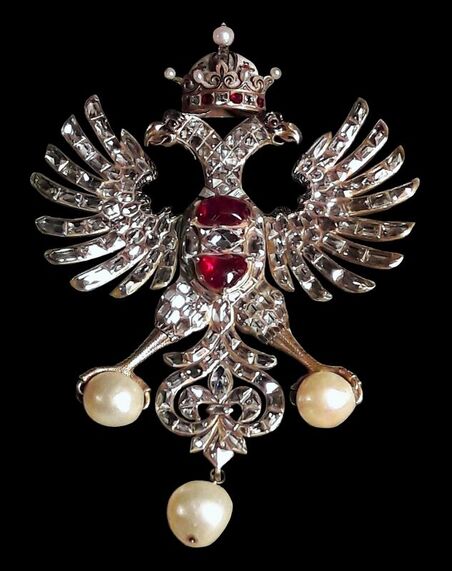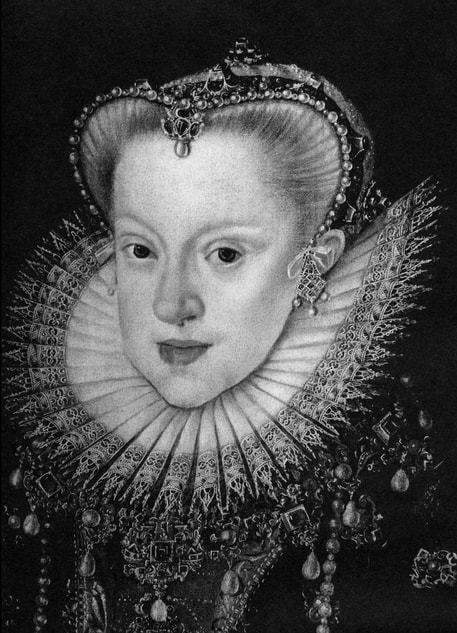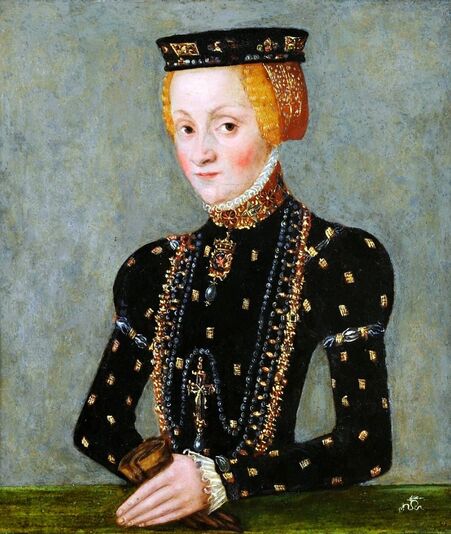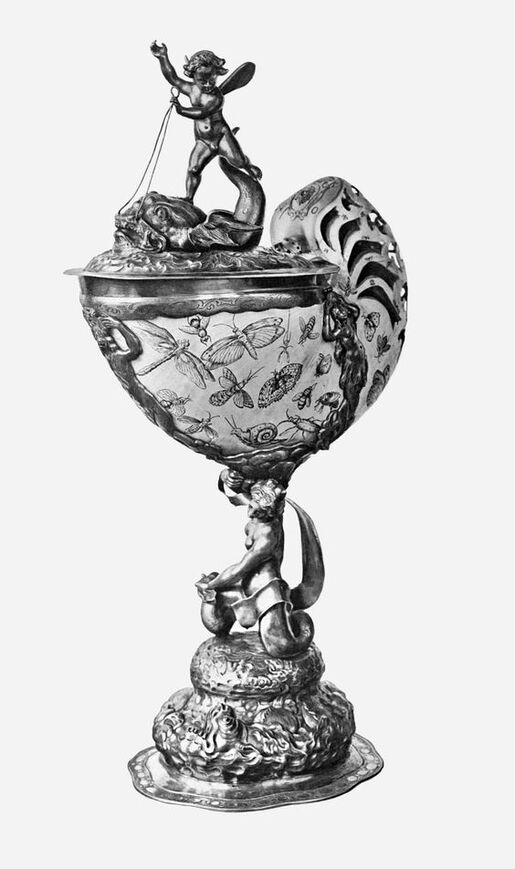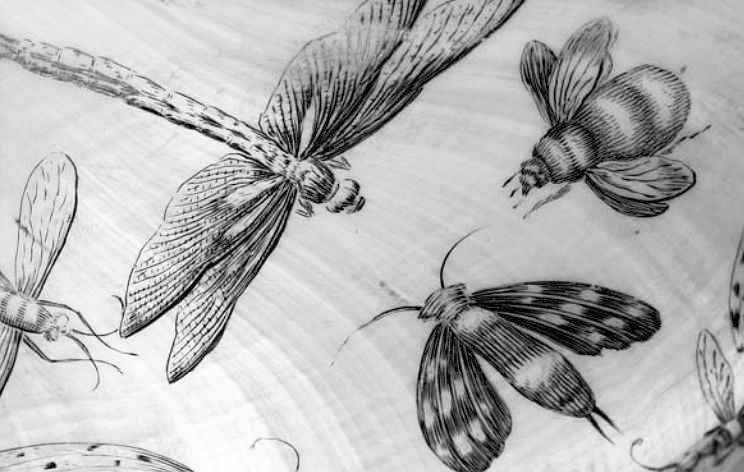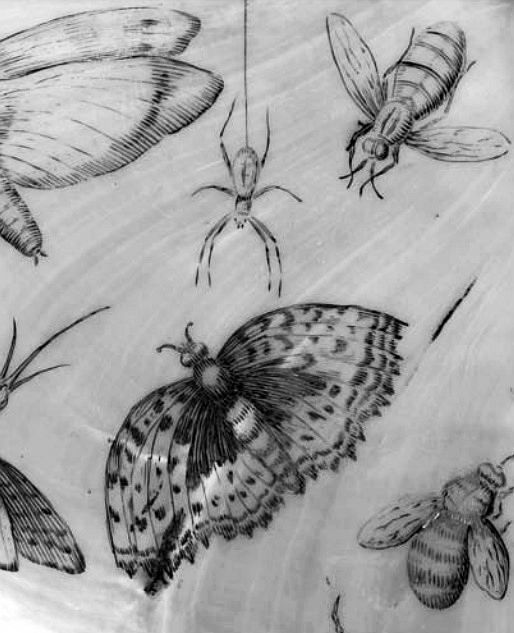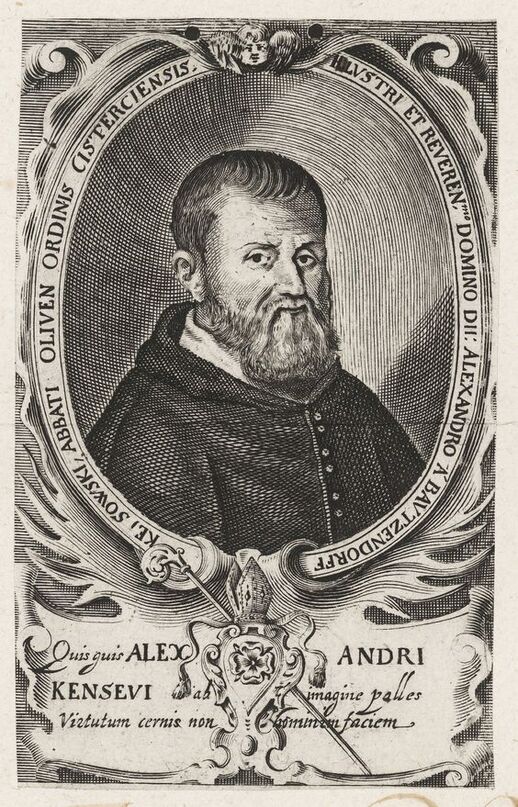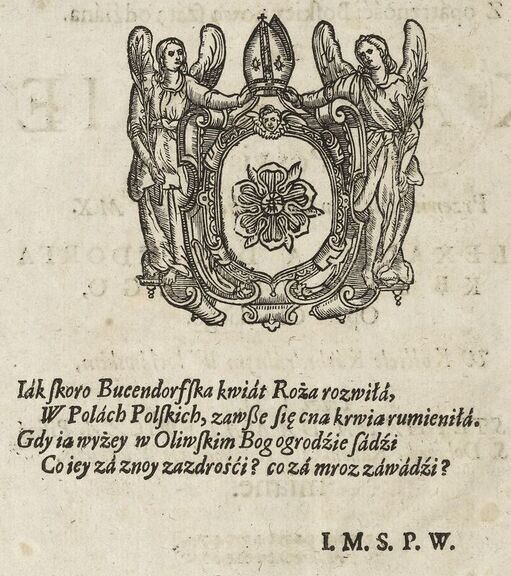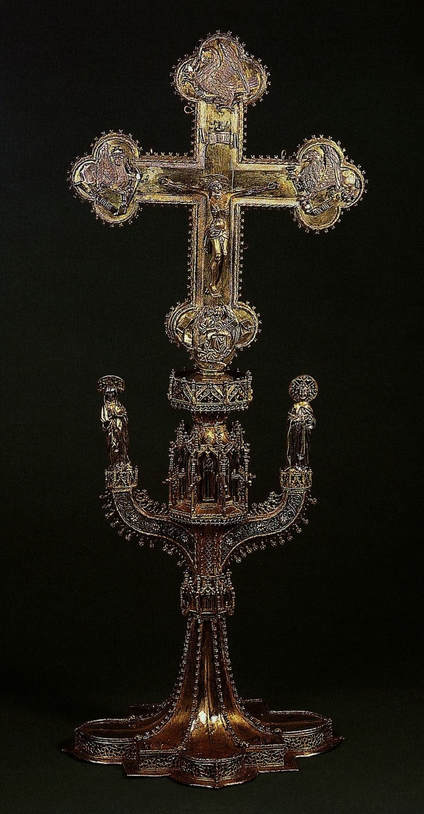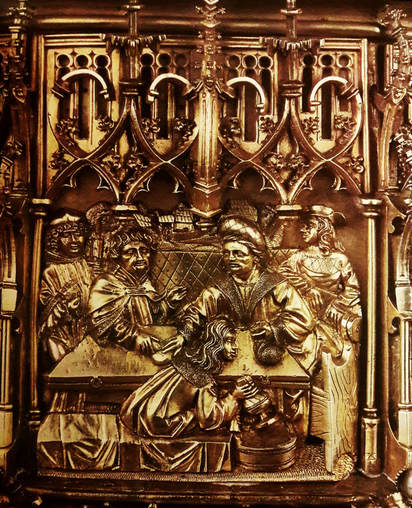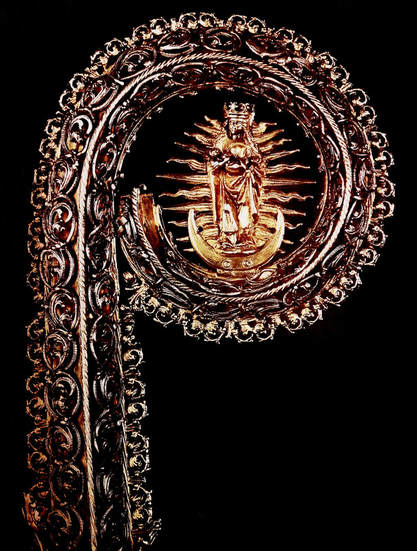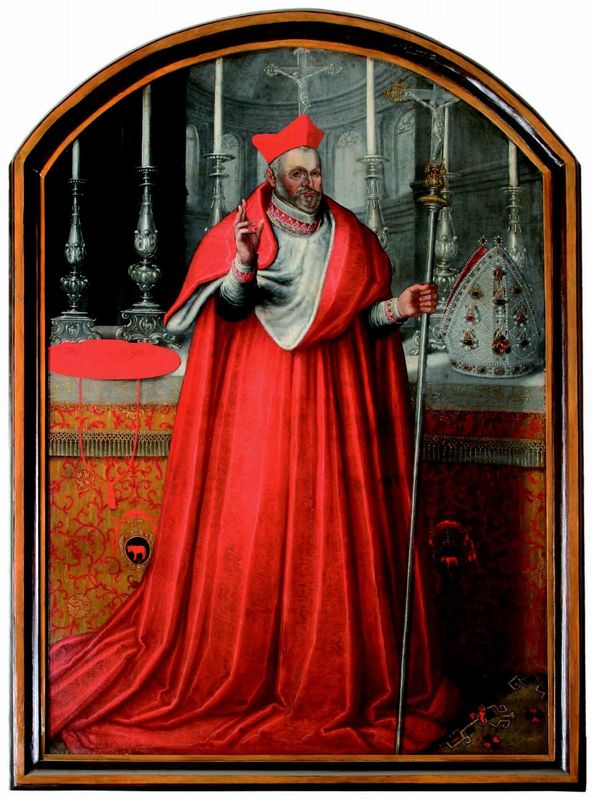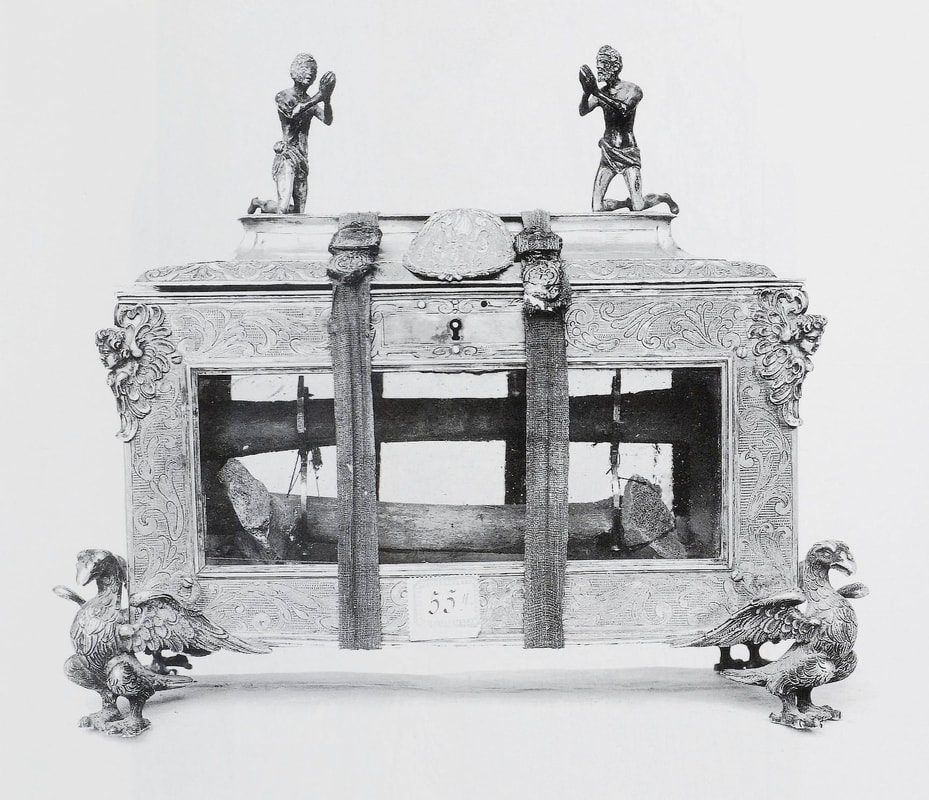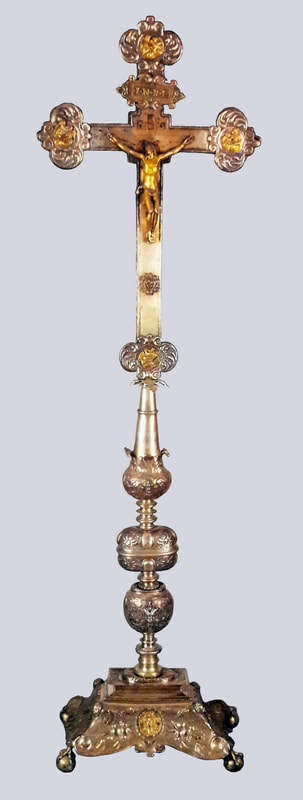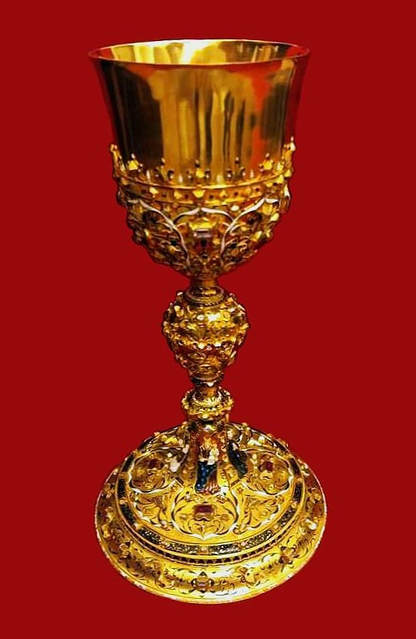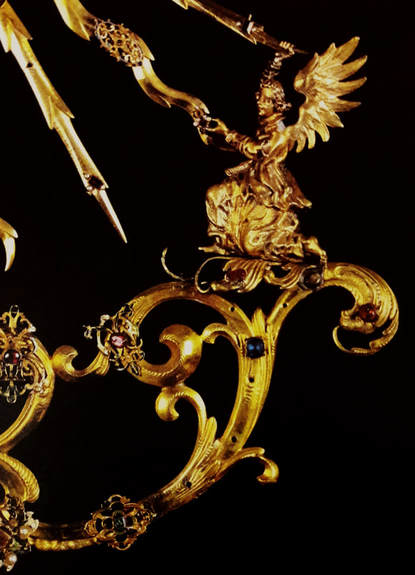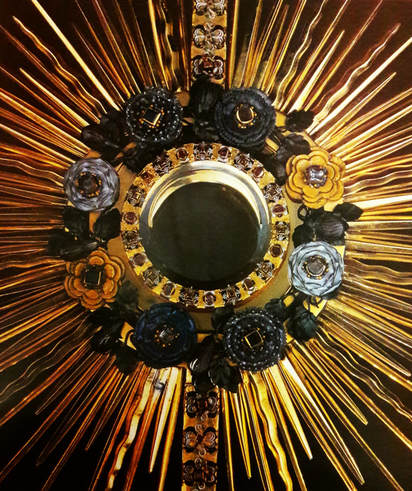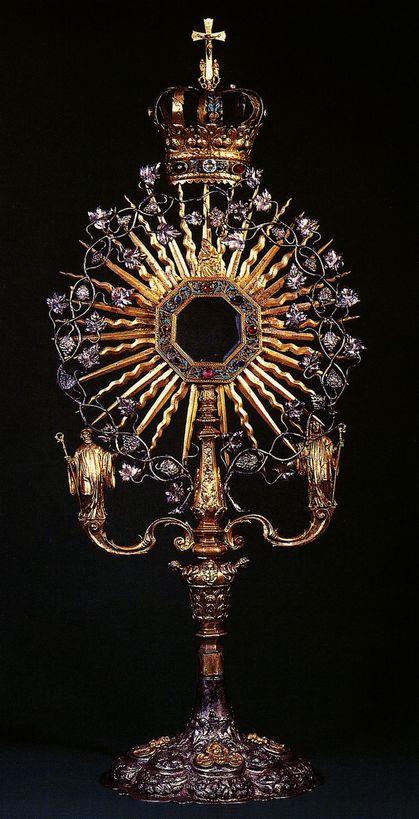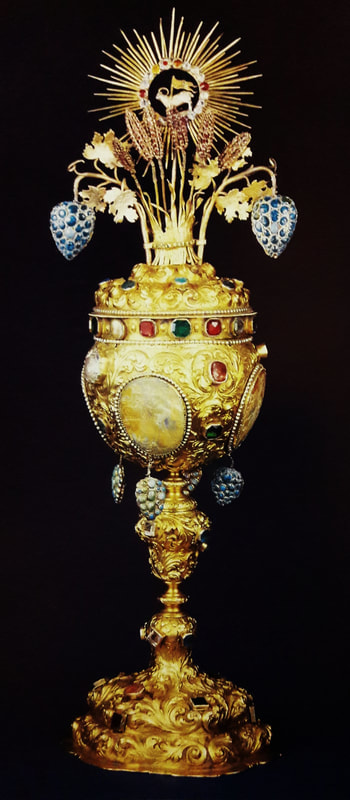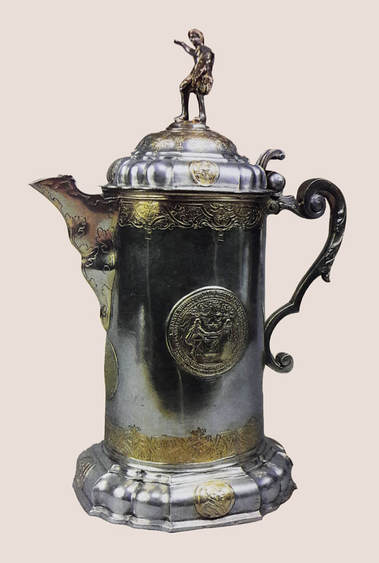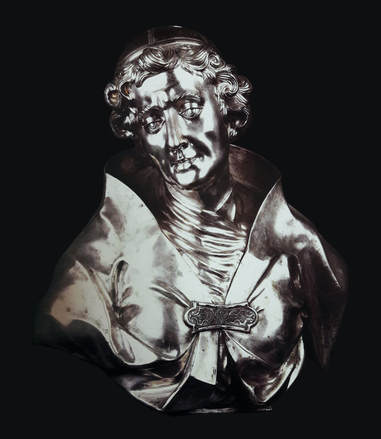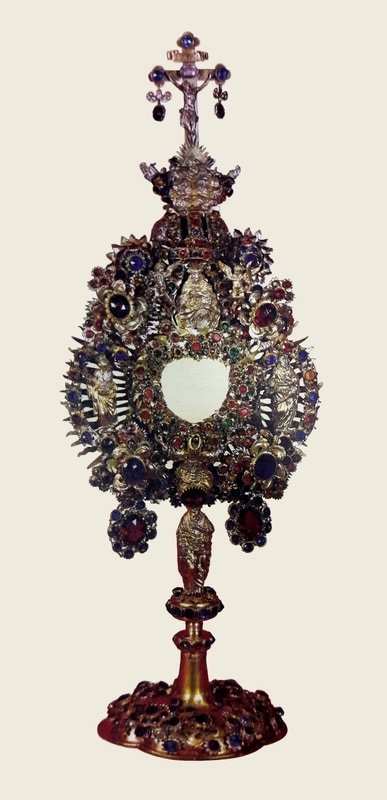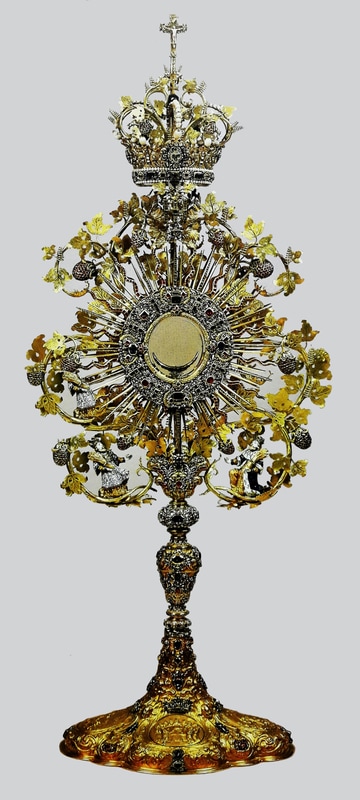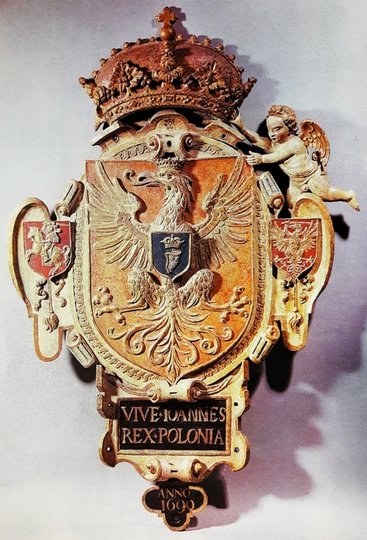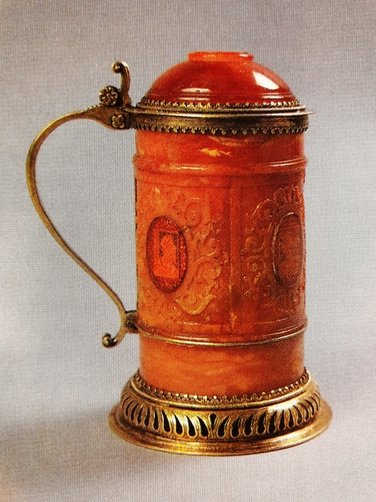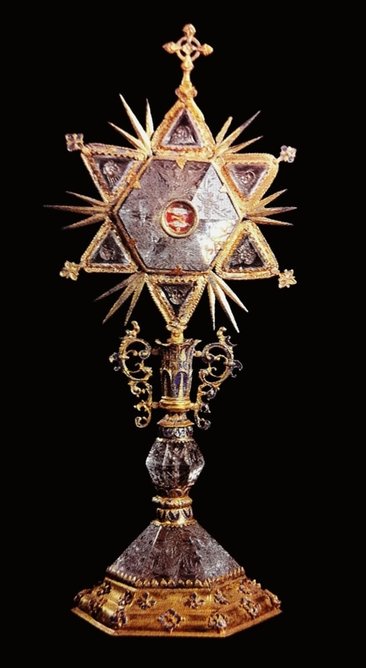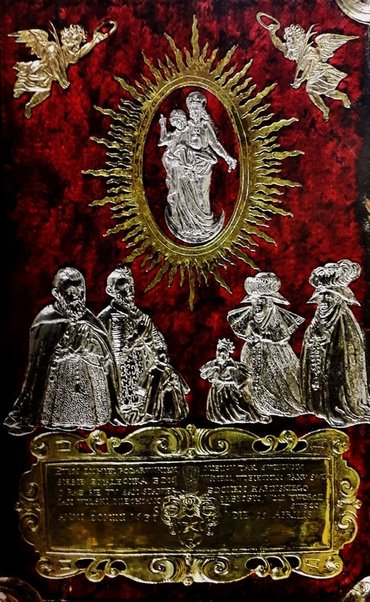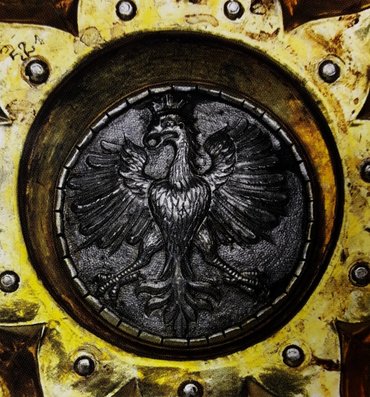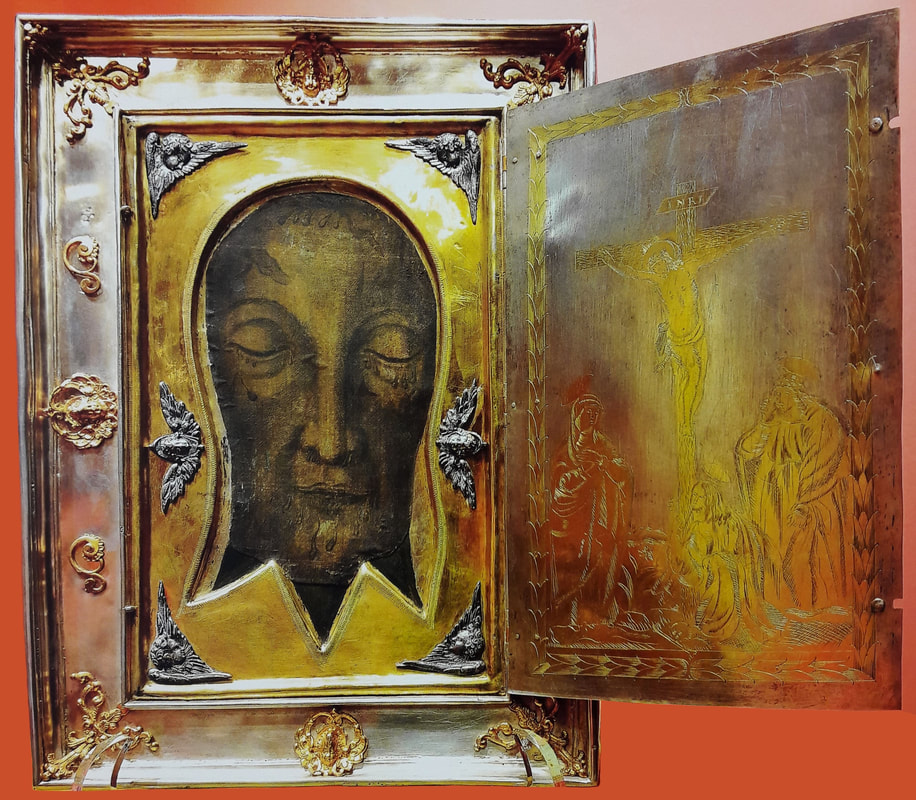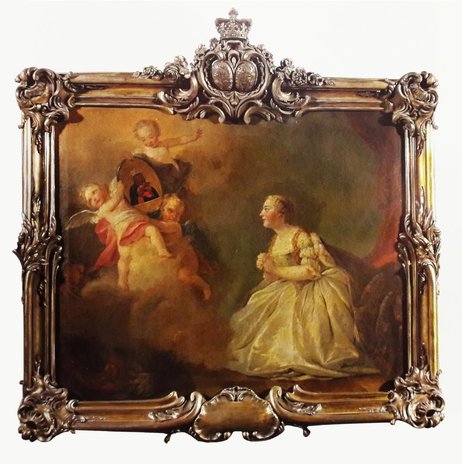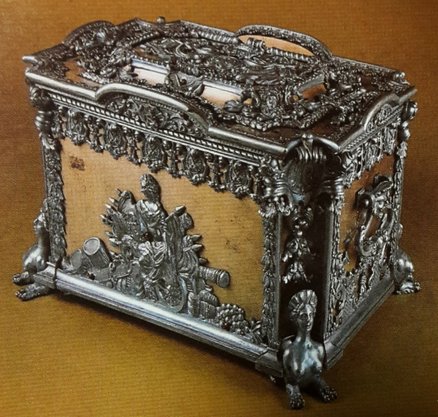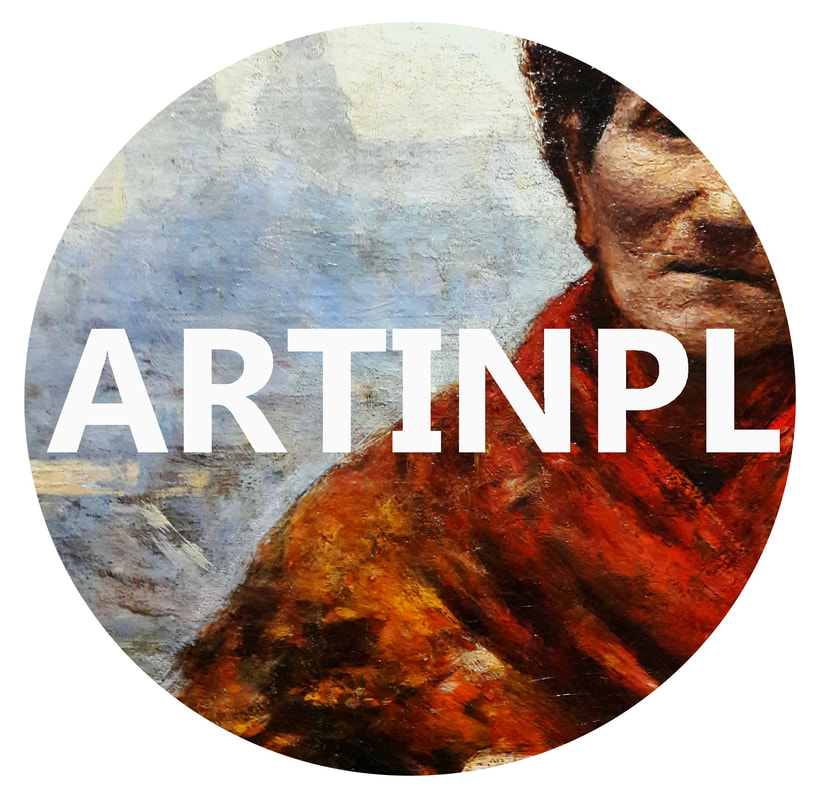|
On June 17th, 1696 died in the Wilanów Palace in Warsaw after 20 years reign, John III Sobieski, elected monarch of the Polish-Lithuanian Commonwealth. Shortly after king’s death an inventory of his belongings in the palace was opened. The document contains 122 positions of exquisite silverware, some of which could be created for 20th anniversary of king’s coronation on February 20th, 1696. In the part of royal treasury supervised by burgrave Brochocki, there was "a silver pyramid with 11 baskets made in Augsburg (No. 9.)", "a silver bowl made in Augsburg with a cover with phoenix (No. 4.)", "a three storey fountain with gilded elements made in Augsburg (No. 8.)" and "partially gilded service made in Augsburg with salt cellars, trays, vinegar cruets, bowls and Hercules in the center (No. 7.)". According to inventory the latter service had total weight of 56 grzywnas and 12 łuty, while the Kraków grzywna, used in Poland after 1650 weighed 201.86 g, therefore total weight of the service was approximately 11,304.16 g. Similar vessel from the Green Vault in Dresden (inventory number IV 292), created in 1617 in Nuremberg by Heinrich Mack and Johann Hauer, meaure 75 cm with 4686 g weight.
The inventory also lists some gifts from foreign monarchs including gold bowl offered by Elector of Brandenburg (till 1657 a fief of the Commonwealth as Duke of Prussia) - “gold bowl in the shape of a shell presented by Elector of Brandenburg with his coat of arms” 894 red zlotys worth, inherited by prince Aleksander Benedykt Sobieski. On March 24th, 1712 arrived to Berlin, a capital of newly created Kingdom of Prussia (earlier Brandenburg), an envoy of the Polish-Lithuanian Commonwealth and Saxony, count Jacob Heinrich von Flemming. His mission was to negotiate alliance against Sweden (diplomatic credentials for Flemming, Dresden March 17, 1712 [O. S. A. Rep. XI: 247 ii Fe. 55]). Both Prussia and Sweden, growing military powers in the region, pose a significant threat to the Commonwealth. Prussia claimed Courland, a vassal Duchy of the Commonwealth, Varmia and Elbląg, while Swedes were even more perilous for elected successor of John III Sobieski, Augustus II the Saxon, called the Strong, as they supported Stanislaus Leszczyński, a candidate to Commonwealth’s crown and Augustus’ rival. The king was prepared to make far-going territorial concessions to alleviate Prussia and the envoy undoubtedly has not arrived barehanded. It is possible then that Augustus has sent from Warsaw a part or whole silver service made for Sobieski, as a gift. Table centerpiece with Hercules carrying the terrestrial globe and royal eagle in the Köpenick Palace, a branch of Museum of Decorative Arts in Berlin (inventory number S 559), is probably the largest and the only preserved part of the mentioned service. It measures 80 cm and bears hallmark of the city of Augsburg as well as master mark LB with a star. Stylistically the work should be attributed to Lorenz II Biller (active between 1678-1726) and dated to 1680s. The work was signed in the center of the celestial globe in Latin: Christoph Schmidt fecit Augustae 1696. Schmidt most probably modified the work by Biller’s workshop, acquired by some important patron that year, John III Sobieski. The statue also bears the date: 17 M 12 [March 1712?] at the bottom of the base on the right, possibly an inventory date. Later the centerpiece was included in the so-called great silver buffet in the Berlin City Castle. Two similar vessels are visible in the drawing from the end of the 18th century, depicting the composition of the silver buffet in about 1763 and are not visible in original composition of the buffet by Johann Friedrich Eosander from 1708. The centerpiece was therefore included in the composition between 1708 and 1763, which makes Polish provenience even more accurate.
Table centerpiece with Hercules carrying the terrestrial globe and royal eagle by Lorenz Biller II and Christoph Schmidt in Augsburg, ca. 1685 and 1696, Museum of Decorative Arts in Berlin.
Fragment of table centerpiece with Hercules carrying the terrestrial globe and royal eagle by Lorenz Biller II and Christoph Schmidt in Augsburg, ca. 1685 and 1696, Museum of Decorative Arts in Berlin.
Banquet given by John III Sobieski to foreign diplomats and Polish dignitaries at Jaworów on 6 July 1684 by Frans Geffels, ca. 1685, National Museum in Wrocław.
Silver buffet in the Berlin City Castle by Martin Engelbrecht, circa 1708, engraving published in Theatrum Europaeum, Volume XVI, 1717, private collection.
See the work in Polish-Lithuanian Treasures.
At the beginning of January 1606 arrived to Kraków Jan Buczynski, secretary of tsar False Dmitry I of Russia, with the mission to acquire jewels for his patron. Several merchants from Kraków and Lviv, as well as jewellers Mikołaj Siedmiradzki and Giovanni Ambrogio Cellari from Milan, encouraged by the prospect of a large gain, embarked on a journey to Moscow.
Princess Anna Vasa (1568-1625) who owned a collection of jewels valued by some at 200,000 thalers, decided also to secretly sell to the tsar a part of it. Stanisław Niemojewski (ca. 1560-1620) of Rola coat of arms, Crown Deputy Master of the Pantry, was appointed to deliver jewels worth of 70,000 zlotys "wrapped in colourful silk" in an iron casked "painted in green". False Dmitry was killed on May 17th, 1606 and it was not as early as 1609 when the collection was returned by the new tsar Vasiliy Ivanovich Shuisky. Among jewels returned was "eagle with two diamond heads with rubies", most probably from princess' collection or pawned with Niemojewski from the State Treasury before 1599. Such hereldic jewels, either Imperial-Austrian or Polish, were undobtedly in possesion of different queens and princesses of Poland since at least 1543, when Elizabeth of Austria (1526-1545) was presented with a "diamond eagle with rubies" by emperor Charles V on the occasion of her marriage with king Sigismund II Augustus of Poland. Inventory of the jewels of Polish princess Anna Catherine Constance Vasa, daughter of Sigismund III and Constance of Austria, include four pendans and two pair of earrings with eagles, unfailingly three Imperial-Austrian and two Polish: "a pendant with a white, enamelled Eagle, at which seven diamonds, three round pearls and one big hanging ", valued at 120 thalers and "a diamond eagle with a sharply cut diamond in the center, more diamonds around and three hanging pearls". Anna Vasa, in half a princess of Poland, as a daughter of Catherine Jagiellon and sister of king Sigismund III, was as such entitled to use this emblem. After Sigismund's defeat at the Battle of Stångebro in 1598, she left Sweden to live with him in Poland where she spent the rest of her life. The miniature portrait of a lady with eagle pendant from Harrach collection in Vienna (Harrach Palace at Freyung Street) previously identified as effigy of Anna of Austria (1573-1598), first wife of king Sigismund III, basing on strong resemblance to portrait of Catherine Jagiellon, if at all connected with Poland, should be rather identified as a portrait of king’s sister Anna Vasa, and not as his wife. The lack of protruding lip, notorious "Habsburg jaw" known from Anna of Austria’s preserved portraits and costume of the sitter, according to Northern fashion and not Spanish of the Imperial court, confirms this hypothesis. Eagle was a symbol of supreme imperial power, epitomized magnanimity, the Ascension to heaven and regeneration by baptism and was used in jewellery all across Europe at that time. If the pendant is a heraldic symbol than the portrait should be dated to about 1592, when Sigismund was prepared to abandon the Polish throne for Ernest of Austria, who was about to marry princess Anna Vasa (this would also explain how the miniature found its way to Austria) or to 1598, when the princess needed to legitimize herself in her new homeland.
Diamond double-headed eagle of the House of Austria by Anonymous from Milan or Vienna, mid-16th century, Treasury of the Munich Residence. Most probably from dowry of princess Anna Catherine Constance Vasa.
Detail of a portrait of queen Anna of Austria (1573-1598) by Martin Kober, 1595, Bavarian State Painting Collections.
Miniature of princess Catherine Jagiellon (1526-1583) by workshop of Lucas Cranach the Younger, ca. 1553, Czartoryski Museum.
Miniature of a lady with eagle pendant, most probably princess Anna Vasa (1568-1625) by Anonymous, 1590s, Harrach collection in Rohrau Castle (?). Identification by Marcin Latka.
See the work in Polish-Lithuanian Treasures.
The Museum of Decorative Arts (Kunstgewerbemuseum) in Berlin prides itself on its collection of over 40 cm high nautilus cup made by the royal goldsmith Andreas I Mackensen (inventory number 1993.63). The cephalopod shell is decorated with a engraved images of insects and bats and mounted in a silver, gilt frame with sea elements - the bowl is supported by Triton, the frame is in the form of sirens and sea waves, and the cover is decorated with a putto gliding on a sea monster. At the base of the cover there is the owner's coat of arms, Aleksander Kęsowski, abbot of the Oliwa Abbey, a six-petal rose and initials A / K / A / O (ALEXANDER / KENSOWSKI / ABBAS / OLIVAE). Kęsowski, born in Kąsów in Kuyavia in 1590, became the abbot in 1641, after the death of Michał Konarski. He was a good manager and founder of many sacred buildings and a hospital of St. Lazarus in Oliwa.
The richness of the Oliwa Abbey during Kęsowski's tenure is evidenced by the account of a gift offered to King John Casimir Vasa and Queen Marie Louise Gonzaga on the occasion of their visit to Gdańsk in 1651. The abbot invited the king to dinner and during this visit he "offered to His Majesty the King the amber clock, very expensive and high, for which he gave in Gdańsk three thousand zlotys [...] to Her Majesty the Queen he offered the amber casket, very beautiful, though small", confirms the royal courtier, Jakub Michałowski, in his diary of the "Prussian Journey". "So we left Oliwa on Wednesday after dinner, accompanied along the way for some time by this abbot [Aleksander Kęsowski], who bid us farewell with good wine with a chalice in his hand" - wrote in his "Diary of travel across Europe" from 1652 Giacomo Fantuzzi, an official of the Apostolic Nunciature in Warsaw, who after seven years in Poland returned to his native Italy via Gdańsk. Earlier on, he noted in his report that here "the dining table is very important and it is very expensive, because in Poland they live sumptuously and they give expensive parties". The cup was probably made in Gdańsk and could be a gift from the king or, more likely, was ordered by the abbot himself. It is possible to set the date of its creation in the interval between 1643, when Mackensen came from Kraków to Gdańsk, and 1667, the date of Kęsowski's death. At the beginning of the 20th century it was owned by count Friedrich Schaffgotsch in Cieplice, after World War II it belonged to Udo and Mania Bey in Hamburg, and in 1993 it was acquired by the Museum of Decorative Arts from Galerie Neuse in Bremen.
Nautilus cup with coat of arms of abbot Aleksander Kęsowski by Andreas I Mackensen, 1643-1667, Museum of Decorative Arts in Berlin.
Detail of nautilus cup with coat of arms of abbot Aleksander Kęsowski by Andreas I Mackensen, 1643-1667, Museum of Decorative Arts in Berlin.
Detail of nautilus cup with coat of arms of abbot Aleksander Kęsowski by Andreas I Mackensen, 1643-1667, Museum of Decorative Arts in Berlin.
Abbot Aleksander Kęsowski in Paweł Mirowski's "Kazanie na pogrzebie zacnego młodziana Jego Mości Pana Jana Bauzendorffa z Kęsowa Kęsowskiego ..." by Anonymous from Gdańsk, 1656, National Library in Warsaw.
Coat of arms of abbot Aleksander Kęsowski in Stefan Damalewicz's "Roza z opatrznośći Boskiey nową szatą odźiana, abo kazanie przy poświącaniu przewielebnego w Chrystusie Oyca, I. M. X. Alexandra Bucendorfa Kęssowskiego ..." by Cezary Franciszek in Kraków, 1642, National Library in Warsaw.
Main religious centers of Poland were also main centers for religious craftemanship in the country. Kraków with its status of coronation city and largest city of southern Poland had an adantage over other locations with the largest number of goldsmiths. A diploma issued in 1478 by Jan Rzeszowski, Bishop of Kraków, Jakub Dembiński, castellan and starost of Kraków, Zejfreth, mayor of Kraków, Karniowski and Jan Theschnar, Kraków's concillors to Jan Gloger, son of Mikołaj Gloger, aurifaber (goldsmith) of Kraków, recognizes Jan as a man of good fame and worthy of admission to the guild of goldsmiths. The document confirms that church had a profound influence on development of this craftsmanship in the country.
Reliquary cross of Andrzej Nosek of Rawicz coat of arms, Abbot of the Tyniec Abbey by Anonymous from Kraków, ca. 1480, Cathedral Treasury in Tarnów.
Fragment of gold reliquary for the head of Saint Stanislaus with selling of a village by Marcin Marciniec, 1504, Cathedral Museum at Wawel Hill in Kraków.
Silver crosier of Bishop Andrzej Krzycki by Anonymous from Kraków, 1527-1535, Płock Cathedral.
Portrait of Primate Bernard Maciejowski (1548-1608) by Anonymous from Kraków, ca. 1606, Franciscan Monastery in Kraków. The Primate was depicted holding silver legate's cross against silver altar set commissioned by him before 1601 in Italy and with a 15th century jewelled mitre of cardinal Frederick Jagiellon.
Reliquary of Saint Stanislaus founded by Bishop Marcin Szyszkowski by Anonymous from Poland, ca. 1616-1621, Basilica of Saint Francis of Assisi.
Silver altar cross offered by Primate Wacław Leszczyński to the Gniezno Cathedral by Anonymous from Poland, first quarter of the 17th century, Archdiocesan Museum in Gniezno.
Gold chalice founded by Anna Alojza Chodkiewicz by Anonymous from Poland, ca. 1633, Treasury of the Lublin Archcathedral.
Fragment of a monstrance adorned with jewels from private donations by Anonymous from Lublin, ca. 1650, Dominican Monastery in Lublin.
Fragment of monstrance adorned with enamel by Anonymous from Poland, 1670s, Treasury of the Jasna Góra Monastery.
Monstrance with St. Benedict and St. Scholastica from the Tyniec Abbey by Anonymous from Lesser Poland, 1679, Cathedral Treasury in Tarnów.
Ciborium adorned with mother of pearl founded by guardian Stefan Opatkowski by Anonymous from Kraków, 1700, Franciscan Monastery in Kraków.
After two centries of domination as the main center of craftmanship of the Polish-Lithuanian Commonwath, the country's main port, Gdańsk, began to decline in the beginning of the 18th century. The transfer of royal court from Dresden, into Warsaw during the Seven Years' War in 1756, ended another half-century hegemony of the Saxon capital. Royal court in the capital of the Kingdom of Poland favored greatly developmnent of local workshops. Also many skilled gold- and silversmiths from other locations began to settle in Warsaw. Among the most notable were Antoni Ignacy Mietelski (d. 1737), originally from Warka, who settled in Warsaw in 1717. In 1725, 1733 and 1737 he was the senior of the city's guild of goldsmiths. Mietelski is the author of two silver jugs in similar proportions, one set with coins from around 1720 (Czartoryski Museum) and the other from 1726 made for the city council and adorned with the symbol of Warsaw - a siren (National Museum in Warsaw). The Warsaw's jug signed with monogram AM was commissioned by the mayor of Warsaw, Józef Benedykt Loupia.
The privilage of king Stanislaus Augustus Poniatowski from 1785 and subsequent orders sanctioned Jewish workshops not affiliated with a guild and impose strict rules on marking the objects (grade of silver, mark of the manufacturer and other hallmarks). Among the most notable goldsmiths of that time were Szymon Stanecki, treasurer of the guild from 1785, active till 1810, who signed his works with monogram SS. He is the author of a silver tureen with handles in the form of a ram's heads and a cover topped with an artichoke dated to about 1785 to 1788 (National Museum in Warsaw). Hil Jakubowicz, a Jewish goldsmith from Łask, who was appionted as one of the five state melters in 1788, is an author of an octagonal filgree basket from about 1785 to 1787. Teodor Pawłowicz, mentioned in the Royal priviledge from 1785 as a deputy senior of the guild and active till at least 1789, and Józef Skalski marking his works with monogram IS, active in the end of the 18th century. Foreigneres are represented by Karl Ludwig from Dresden, mentioned in the books of the Węgrów-Warsaw evangelical parish in 1785 and author of two silver tureens signed with monogram CL. Martin Holck, mentioned in the books of the mentioned parish in 1783 and active till 1794, Josef Götz called Gallus from Moravia, active in Warsaw from about 1773 till the end of the century and J.M. Schwartz who signed his works with monogram I.M.S. Unidentified by name silversmiths are Monogrammist IGB, possibly from Poznań, active from the 1770s till the end of the century, author of two tureens from the service of Michał Kemblan Chelkowski, chamberlain of king Stanislaus Augustus that can be dated to about 1785 to 1788.,Monogrammist ASW, Monogrammist GSS and Monogrammist AK, all active in Warsaw in the 1780s.
Silver jug with marriage medal of king Ladislaus IV Vasa and Cecilia Renata of Austria by Antoni Ignacy Mietelski, ca. 1720, Czartoryski Museum.
Silver bust of Saint Stanislaus from Gniezno Cathedral by Anonymous from Warsaw, 1726, Museum of the Gniezno Archdiocese.
The richly decorated 17th-century monstrance of Bishop Stanisław Kazimierz Dąmbski's foundation, is used exclusively for displaying the Blessed Sacrament on Good Friday and during the solemn procession of the Resurrection on Holy Saturday. It was created between 1680 and 1699 possibly by a Silesian goldsmith Christian Schrötter in Kamienna Góra. Made in silver and adorned with semi-precious stones, it represents Christ in the form of a Host, accompanied by figures from the Old (Abraham, Melchizedek) and New Testament (Mother of God, St. Joseph, St. Peter). It was bequeathed to the Wawel Cathedral by the founder as an equivalent for the gold chalice and silver sanctuary lamp offered traditionally by the bishops at their inauguration.
Bishop Stanisław Dąmbski's monstrance by Christian Schrötter in Kamienna Góra, 1680-1699, Cathedral Museum at Wawel Hill in Kraków.
The monstrance, a chief example of the 17th century Polish goldsmithery, was commissioned by Augustyn Kordecki, Abbot of the Jasna Góra Monastery and later Provincial of the Pauline Fathers, as an ex-voto for the defence of the monastery during the invasion of the Polish-Lithuanian Commonwealth by the neighbouring nations in 1655, so-called Deluge. It was created in 1672 in Warsaw by Royal goldsmith Wacław Grotko from Prague in Czechia (also known as Grottke or Grottkau, active in Warsaw between 1665 and 1675), who was paid 30,000 zlotys in gold.
The work was made from jewels donated by pilgrims to the monastery. Over one meter high (103 cm) and over 13 kg weight monstrance was adorned with 2.366 diamonds, 2.208 rubies, 30 saphires, 81 emeralds, 215 pearls and enamel. A large diamond set in the crown at the top, was bequeathed to the monastery by Zygmunt Przerembski, voivode of Sieradz in 1668. Prophet Aaron and King David kneeling at both sides of the glory are holding wheat sheaves, an eucharistic symbol. Scenes at the foot of the monstrance are related to two themes: the sacrifice of Christ (the Sacrifice of Abraham and the Passover) and the eucharist (Elijah in the Desert and the Last Supper). According to inscription on the base of the monstrance, Father Augustyn Kordecki was Provincial, Father Stanisław Ligęza was Abbot of the Jasna Góra Monastery and Father Romuald Dymalski was Sacristan of the monastery at the time of its creation.
Abbot Augustyn Kordecki's monstrance by Wacław Grotko in Warsaw, 1672, Treasury of the Jasna Góra Monastery.
Main centers of craftsmanship in the Polish-Lithuanian Commonwealth (PLC) in the late 16th and at the beginning of the 17th century, a period dominated by late Renaissance forms in arts, were large cities like Gdańsk, Poznań, Vilnius, Lviv and Kraków. Although now perceived as former German territory, Königsberg, known in Polish as Królewiec, was at that time the capital of Duchy of Prussia, a fief of the Crown of Poland, hence part of the Commonwealth and one of the country's important production and trade centers. Amber crafts developed therein, can be therefore considered as integral part of the PLC's production. Mannerist forms in applied arts prevailed till mid-17th century.
Carouche with coat of arms of the Polish-Lithuanian Commonwealth by Anonymous from Gdańsk, 1612, Artus Court in Gdańsk. Modified in 1690 to honour John III Sobieski.
Amber tankard in silver frame by Anonymous from Königsberg, ca. 1610, Czartoryski Museum.
Rock crystal reliquary in silver frame by Anonymous from Kraków, beginning of the 17th century, Mogiła Abbey.
Silver votive plaque with velvet background of Jan Wolski by Anonymous from Poland, 1631, Treasury of the Jasna Góra Monastery.
Polish Eagle, fragment of silver goblet with Saint Catherine by Anonymous from Kraków, first quarter of the 17th century, Kremlin Museum.
Vera icon of Constance of Austria in a silver-gilt frame founded by Primate Jan Wężyk by Anonymous from Poland, 1630s, Diocesan Museum in Łowicz.
Maria Josepha of Saxony visited the Jasna Góra Monastery with her sister Maria Anna Sophia on May 23rd, 1744. Daughters of Augustus III of Poland and Saxony offered to the Black Madonna of Częstochowa two gold hearts with their names as votive offering. In 1747 the princess married Louis, Dauphin of France (1729-1765) and some time later, in 1756, through intermediary of Duchess Jabłonowska, she sent to Jasna Góra a votive offering for healing her husband. The oil on canvas painting by anonymous French painter is set in a rich bronze frame, cast, chased and gilded, adorned with rocaille motifs and cartouches with coat of arms of Maria Josepha (Polish-Lituanian Commonweath and Kingdom of France). Inscription on frame informs about the intentions of the Dauphine of France. Both the painting and frame were creted by French workshop. Similar example of craftmanship is a late baroque strongbox with monogram of Augustus II of Poland by Pierre Fromery.
Votive painting of Maria Josepha of Saxony by Anonymous from France, ca. 1753, Treasury of the Jasna Góra Monastery.
Strongbox with monogram of Augustus II the Strong by Pierre Fromery, 1697-1733, Czartoryski Museum.
|
Artinpl is individual, educational project to share knowledge about works of art nowadays and in the past in Poland.
If you like this project, please support it with any amount so it could develop. © Marcin Latka Categories
All
Archives
April 2023
|
